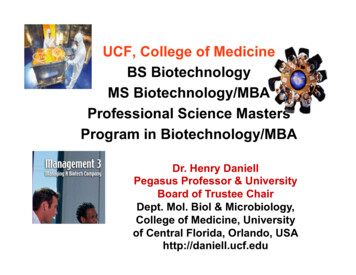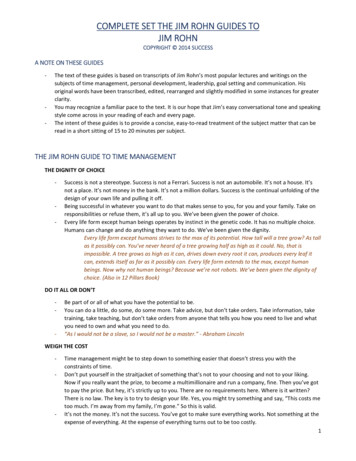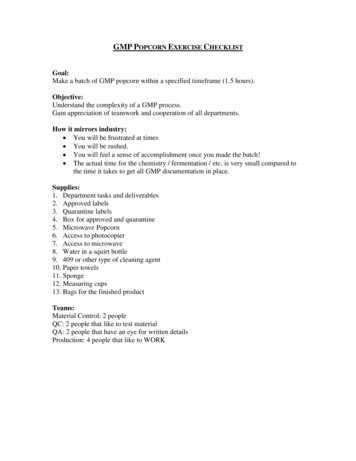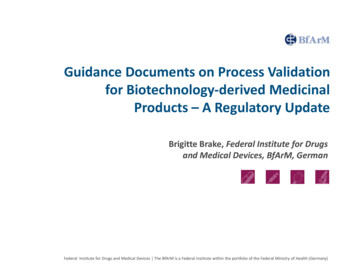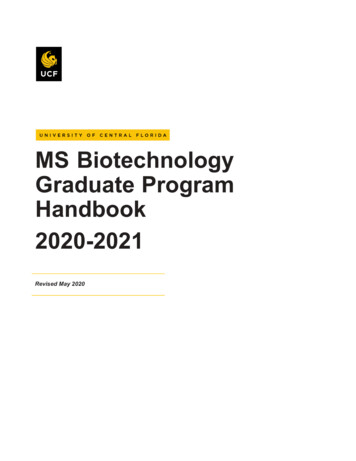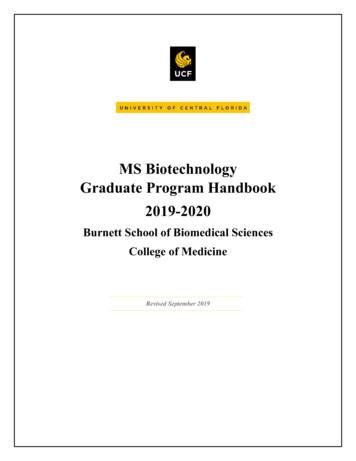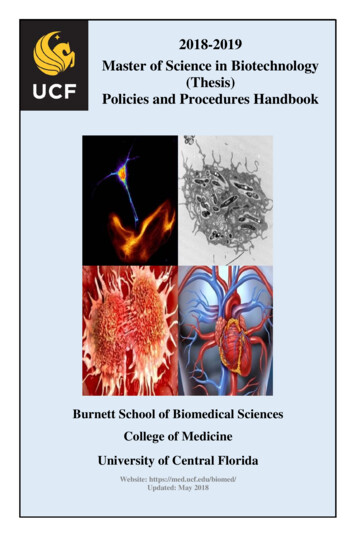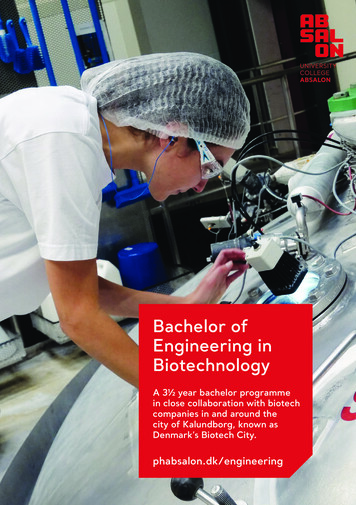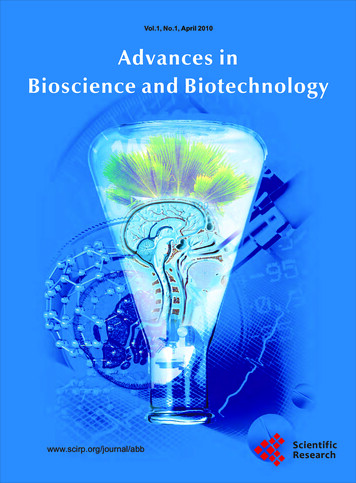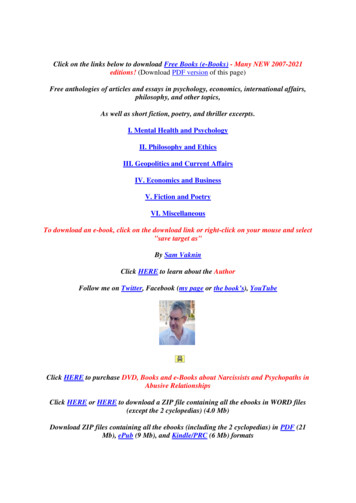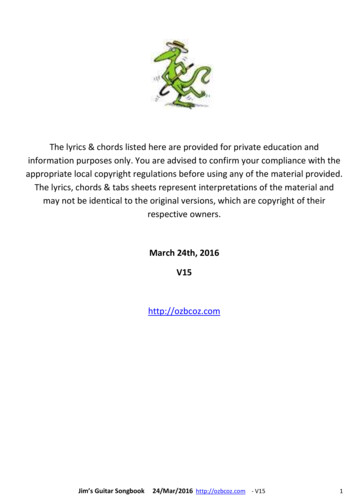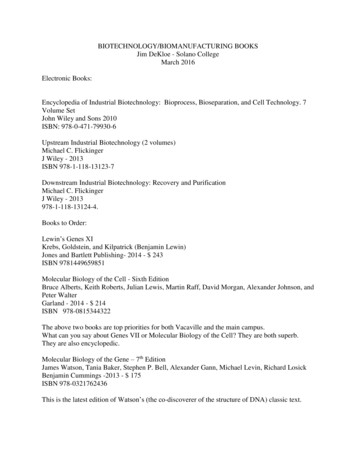
Transcription
BIOTECHNOLOGY/BIOMANUFACTURING BOOKSJim DeKloe - Solano CollegeMarch 2016Electronic Books:Encyclopedia of Industrial Biotechnology: Bioprocess, Bioseparation, and Cell Technology. 7Volume SetJohn Wiley and Sons 2010ISBN: 978-0-471-79930-6Upstream Industrial Biotechnology (2 volumes)Michael C. FlickingerJ Wiley - 2013ISBN 978-1-118-13123-7Downstream Industrial Biotechnology: Recovery and PurificationMichael C. FlickingerJ Wiley - 2013978-1-118-13124-4.Books to Order:Lewin’s Genes XIKrebs, Goldstein, and Kilpatrick (Benjamin Lewin)Jones and Bartlett Publishing- 2014 - 243ISBN 9781449659851Molecular Biology of the Cell - Sixth EditionBruce Alberts, Keith Roberts, Julian Lewis, Martin Raff, David Morgan, Alexander Johnson, andPeter WalterGarland - 2014 - 214ISBN 978-0815344322The above two books are top priorities for both Vacaville and the main campus.What can you say about Genes VII or Molecular Biology of the Cell? They are both superb.They are also encyclopedic.Molecular Biology of the Gene – 7th EditionJames Watson, Tania Baker, Stephen P. Bell, Alexander Gann, Michael Levin, Richard LosickBenjamin Cummings -2013 - 175ISBN 978-0321762436This is the latest edition of Watson’s (the co-discoverer of the structure of DNA) classic text.
Culture of Animal Cells: A manual of Basic Technique and Specialized ApplicationsSeventh EditionIan FreshneyJohn Wiley and Sons - 2016 - 94ISBN 9781118873656Freshney’s Cell Culture book remains the classic book on cell culture in the latest edition. Weshould order a copy for both Vacaville and Fairfield campuses.Molecular Cell Biology – 8th EditionHarvey Lodish, Arnold Berk, Chris Kaiser, Monty Krieger, Anthony Bretscher, Hidde Ploegh,Anjelica Amon, Matthew P. Scott, and Kelsey MartinW. H. Freeman - 2016ISBN: 978-1464183393This latest edition will be released March 16, 2016.Proteins: Biochemistry and Biotechnology 2nd EditionGary WalshJ. Wiley-Blackwell - 2014ISBN 978-0470669853This book covers basic protein structure, the production of proteins, protein purification, proteinstability, and the production and biological action of specific protein classes.Pharmaceutical BiotechnologyDaan J. A. J. Crommelin, Robert D. Sindelar,Springer Publishing - 2013 - 80.00ISBN: 978-1461464853The authors wrote this excellent book to inform pharmacists and other members of that industryabout the drugs that are produced by the biotechnology field. This book has Chapters on proteinstructure and general biochemistry, on fermentation and cell culture, on downstream proteinpurification processes, on formulation (a subject difficult to find materials), and on drug deliveryand pharmacokinetics (again, these are areas where it is difficult to find references.) Its lastChapters cover specific pharmaceutical proteins like insulin, hematopoietic growth factors,deoxyribonuclease, tissue plasminogen activator, growth hormone, monoclonal antibodies, andvaccines. It also has a Chapter on professional educationBasic Biotechnology – Third EditionColin Ratledge and Bjorn KristianssonCambridge University Press - 2006 - (hardcover 120)ISBN - 9780521549585This is an excellent reference. It contains the background on the science of biotechnology as wellas chapters on business topics. I believe that the Third Edition is the most recent, but thelibrarians should double check this. We should have a copy in Vacaville and on the maincampus.
Bioprocess Engineering : Basic Concepts 2nd Editionby Michael L. Shuler, Fikret KargiPrentice Hall - 2001 - 89ISBN: 978-0130819086This classic book views biotechnology (and biology/microbiology) through the eyes of achemical engineer. It has an excellent section on the history of the field. It also had severaldense and thorough chapters on biology to bring engineers up to speed. I use this as a referencequite a bit. It is written for engineers at the senior or graduate level.Medical BiotechnologyBernard R. Glick, Terry L. Dolovich, and Cheryl L. PattenASM Press - 2014 - 120IBSN 9781555817053Molecular Biotechnology - Fourth EditionPrinciples and Applications of Recombinant DNABernard R. Glick, Jack J. Pasternak, and Cheryl L. PattenASM Press - 2010 - 120ISBN 9781555814984This book is well written, but the level may prove challenging for lower division students. Theirinclusion of the discussion of key historic papers from the scientific literature adds an interestingand important component. It has very good sections on fermentation and cell culture, a sectionon government regulation of the industry, and a section on patents. It does explore the businessend of biotechnology some.Bioethics and Medical EthicsEthical Issues in BiotechnologyRichard SherlockRowman & Littlefield Publishers 20029780742513778Principles of Biomedical Ethics, 7th EditionTom Beauchamp & James ChildressOxford University Press – 2012ISBN 9780199924585Bioethics: An Anthology, 3rd Edition,Helga Kuhse, Udo Schüklenk, Peter Singer (Eds.)Wiley – Blackwell 2015ISBN 978-1-118-94152-2Fundamental Immunology – 7th EditionWilliam PaulLWW - 2012ISBN: 978-1451117837
EngineeringMeasurement, Monitoring, Modelling and Control of BioprocessesCarl-Fredrik Mandenius, Nigel J Titchener-Hooker (Eds.)Springer-Verlag (2015)ISBN: 9783642368370 369Bioprocess Monitoring and ControlMarie-Noelle A PonsJohn Wiley and Sons – 19959780471037149Computational Intelligence Techniques for Bioprocess Modelling, Supervision and ControlMaria Carmo NicolettiSpringer 2014ISBN 978-3642424861 - 269Practical Design of Experiments: DoE Made Easy!Colin HardwickCreateSpace Independent Publishing Platform; 1 edition - 2013978-1482760996A DOE Handbook: A Simple Approach to Basic Statistical Design of Experiments,Bert Gunter, Daniel ColemanCreateSpace Independent Publishing Platform; 1 edition - 2014ISBN 978-1497511903Design and Analysis of Experiments – 8th EditionDouglas C. MontgomeryJ. Wiley - 2012ISBN 978-1118146927Student Solutions Manual Design and Analysis of Experiments, 8e Student SolutionsDouglas C. Montgomery, Lisa Custer and Daniel R. McCarvilleJ. Wiley - 2012ISBN 978-1118388198Bioprocess Engineering Principles, 2nd EditionPauline M. DoranAcademic Press – 2012ISBN 978-0122208515Cell Culture Technology for Pharmaceutical and Cell-Based Therapies (Biotechnology andBioprocessing)Sadettin Ozturk and Wei-Shou HuCRC Press
ISBN 9780824753344Cell Culture Bioprocess EngineeringWei-Shou HuCRC PressISBN 978-0985662608These books are already in the collection on the main campus:Biopharmaceuticals: Biochemistry and BiotechnologyGary WalshJ. Wiley Press - 1998ISBN 0471977896 (paper) - 69.95 0471977888 (hardcover) - 150This is the book that served as the text for Solano College’s biotechnology lecture course. Themain useful chapters are Chapter 2 (The drug development process) and Chapter 3 (The drugmanufacturing process), which are excellent. It is weak on upstream processes like fermentationand cell culture. Chapter 2 and Chapter 3 combine for 82 pages, which is like a small book, butthe rest of the book covers particular proteins and protein classes so it is less useful for a generalcourse (although it makes a useful reference.) Between these two Chapters, the book covers thebasics of cell culture, cell banks, protein recovery and purification, formulation, filling andlyophilization, clean rooms, QC analysis and the equipment that performs it, pyrogen detection,protein degradation pathways, regulation by the FDA and international regulatory agencies, goodmanufacturing practice, pharmacopoeias, and the cleaning and sterilization of equipment. Itcontains many photographs of large scale fermentation and recovery equipment. It begins with adiscussion of the production of traditional pharmaceuticals and later includes proteinpharmaceuticals; this provides an interesting contrast between Big Pharma and biotechcompanies.Molecular Biotechnology - Second EditionS. B. PrimroseBlackwell Scientific Publications - 1991ISBN 0-632-03053 (for the paperback) - 50Molecular Biotechnology is written using clear language and written at the appropriate level,although parts of it will probably (appropriately) challenge lower division students. This bookcovers the history of the field well, covers recombinant DNA well, and has an excellent sectionon cell culture and fermentation, and on the production of monoclonal antibodies. It has majorholes - especially in recovery and downstream processes - which it basically ignores. Jim triedto use this as a text in 1998, but the publisher couldn’t supply it in sufficient numbers. It’sbeginning to be difficult to find.Pharmaceutical BiotechnologyDaan J. A. J. Crommelin, Robert D. Sindelar,Gordon and Breach Publishing - 1997 - 65.00ISBN: 9057022494The authors wrote this excellent book to inform pharmacists and other members of that industryabout the drugs that are produced by the biotechnology field. Solano College tried to use this as
their text during Fall semester 2002, but the publisher informed us that it had gone out of print.This book has Chapters on protein structure and general biochemistry, on fermentation and cellculture, on downstream protein purification processes, on formulation (a subject difficult to findmaterials), and on drug delivery and pharmacokinetics (again, these are areas where it is difficultto find references.) Its last Chapters cover specific pharmaceutical proteins like insulin,hematopoietic growth factors, deoxyribonuclease, tissue plasminogen activator, growth hormone,monoclonal antibodies, and vaccines. It also has a Chapter on professional education.Proteins: Biochemistry and BiotechnologyGary WalshJ. Wiley - 2002ISBN 0-471-89907-0This new book covers basic protein structure, the production of proteins, protein purification,protein stability, and the production and biological action of specific protein classes.Protein BiotechnologyGary Walsh and Denis R. HeadonJohn Wiley & Sons - 1994, reprinted 1996ISBN 0-471-94393-2 Cost 70Jim used this book in the past as the text for his biotech courses, and this is the book thatGenentech used as the text for their in-house training course in 1996 and 1997. Sonia Wallman,who has an excellent biotech program at New Hampshire Technical College used this book also.This book is written at the appropriate level for freshman/sophomore/reentry students and itcovers many issues in process science and manufacturing. It has an excellent discussion ofrecovery and downstream processes, but is weak on the upstream topics. It also has a Europeanbias, that is, it emphasizes regulation of the industry by the European Union rather than by theFDA - this makes it less useful for an American program.Pharmaceutical BiotechnologyFundamentals and EssentialsMelvin E. Klegerman and Michael J. GrovesInterpharm Press - 1992IBSN 0-935184-6 Cost 107This is an excellent reference book that emphasizes the topics important for manufacturing; itcovers exactly the right topics. It is written for researchers in the field, so the level isinappropriately challenging for a lower division college student. The multiple authors meansthat it also suffers from an uneven writing style. Also, it’s very expensive. Jim uses itextensively as a reference to prepare lectures.Molecular Biotechnology - Second EditionPrinciples and Applications of Recombinant DNABernard R. Glick and Jack J. PasternakASM Press - 1998 - 50ISBN 1-55581-136-1
This book is well written, but the level may prove challenging for lower division students. Theirinclusion of the discussion of key historic papers from the scientific literature adds an interestingand important component. It has very good sections on fermentation and cell culture, a sectionon government regulation of the industry, and a section on patents. It does explore the businessend of biotechnology some.Biotechnology - A Textbook of Industrial Microbiology (Second Edition)Wulf Crueger and Anneliese CruegerSinauer Associates, Inc. - 1989ISBN 0-87893-131-7Karen McDonald of UC Davis has used this book in the past as a text for her fermentationscience course. Jim uses it as a reference. It is hard to find.Protein Purification - Principles and PracticeThird EditionRobert K. ScopesSpringer Verlag - 1994 - 69.95ISBN 0-387-9-4072-3William Ward of Rutgers University who runs an excellent summer workshop on GreenFluorescent protein recommended this book; it is very good. Jim uses it as a reference for thetheory behind protein separation techniques. It covers the principles behind protein precipitation,centrifugation, electrophoresis, and many types of chromatography. It has a section on scale upand a final chapter on the optimization of the process. It contains many useful graphs anddiagrams.THE BUSINESS SIDE OF BIOTECHNOLOGYFrom Alchemy to IPOCynthia Robbins-RothPerseus Publishing - 2000 - 260-7382-0253-3This clearly written book focuses on the business side of biotechnology and it begins with thefounding of Genentech and Amgen as case studies. The author was a research scientist atGenentech in the early days and explains in detail how Bob Swanson and Herb Boyer began theircompany and kept it afloat during its early vulnerable years. Dr. Robbins-Roth left the lab benchto become a biotech business writer and consultant, and she brings her science background toanalysis of business trends. Her website is www.bioventureconsultants.com Jim uses this as thetext to accompany his business class.Biotechnology - The Science and the Business - Second EditionDerek G. Springham, Ronald Cape, and Vivian Moses (Editors)Gordon and Breach Publishing - 1999
ISBN 9057024063 (Hard Cover) Cost 150ISBN 9057024071 (Soft Cover) Cost 56This book does exactly what a book for a comprehensive course should do: it integrates adiscussion of the science behind biotech with the business end and the regulatory end. It suffersfrom the blessing and curse of different authors writing every chapter: they know their subjectbut the writing style is very uneven. Another blessing and curse, it covers the broadest possiblecomponents of the field and includes alcohol production, flavor ingredients, pesticides, and oilproduction. Ronald Cape, one of the founders of Cetus, served as one of the editors for the firstedition and this new edition still makes many references to long-dead Cetus. The regulatorydiscussions, although they do cover oversight by the FDA and U.S. Patent law, often show aEuropean bias. Last, it’s expensive; the hardback costs 150 although the paperback can bepurchased for 56.Exploiting BiotechnologySheila Moses and Vivian MosesHardwood Academic Publishers - 1995ISBN 3-7186-5570-5 (hardcover) - 64ISBN 3-7186-5571-3 (softcover) - 28One of the authors of the above book wrote this book. It is not as comprehensive as the“Biotechnology - The Science and the Business” book above, but it has several interestingchapters on intellectual property (Chapter 5), management (Chapter 6), and changes in healthcare(Chapter 7). Jim found it in one library, but had trouble finding himself a copy.First Fruit: The Creation of the Flavr Savr Tomato and the Birth of Biotech FoodBelinda MartineauMcGraw-Hill - 2001 - 24.95ISBN 0-07-136056-5The author is a former Calgene scientist who tells the inside story of the Flavr Savr tomato, thefirst Genetically Modified food to go to market. After their release, these tomatoes enjoyed abrief period of glory, and then suffered a spectacular decline and ultimate failure. It is a veryinteresting story of good science and bad business.Evolutionary Innovations: The Business of BiotechnologyMaureen McKelveyOxford University Press - 2000 - 29.95ISBN 0198297246The Golden HelixArthur KornbergUniversity Science Books - 1995 - 29.95ISBN 0935702326The Biotech Investor’s Bible
George WolffJohn Wiley and Sons - 2001 - 29.95ISBN 0471412791This book explains the business side of biotechnology to investors, and contains a very goodassessment of individual biotechnology companies. Specifically, it ranks biotech companies into“tiers” according to their maturity and potential, with “Tier 1" being the very few biotechcompanies that are actually breaking even. It’s good to get a feel for the way that investors viewthe industry.BOOKS FOR A GENERAL AUDIENCE OR AN INTRODUCTORY COURSEDNA - The Secret of LifeJames D. Watson with Andrew BerryAlfred A. Knopf - 2003 - 30ISBN 0-375-41546-7This excellent new book by Watson has been written for a popular audience and contains thescientific basis and the history of the discovery of the central dogma, recombinant DNA, and ofthe genomics revolution. It’s typical Watson: opinionated, a bit brash, but well written. Thephotographs are excellent and give it the feel of a coffee table book.Biotechnology - Third EditionJohn E. SmithCambridge University Press - 1997 - 20ISBN 052144911-1This is an excellent introductory book for a popular audience. It’s clearly written (at the collegefreshman level), provides good (and broad) background in the field, and it does cover processtechnologies. We couldn’t find any substantial inaccuracies. It has introductory chapters onintellectual property, safety, and bioethics. It is probably not appropriate as a text because itdoes not cover the subjects in enough depth. Also, it does have a British bias. Give this to astudent who is just beginning, or to a friend who asks you what you do .Molecular Biology Made Simple and Fun - Second EditionLonnie Russell and David ClarkCache River Press - 2000ISBN 0-9627422-9-5 - 34.95This is a remarkable book that tackles advanced subjects with cartoons and humor. Some highschool teachers that I know have tried to use it, but they report that it is a bit advanced for thisapplication. It has humorous diagrams (cheerleaders with card-section signs saying, “give me anA.give me a T” for example), but the format is deceptive since the subject matter is advance;Jim refers to this book quite a bit in preparations of lectures. At the end of the book, it has anamusing appendix that has a “typical seminar” with the techincal terms on one side and a runningcommentary that translates it into English in a neighboring column.
The Cartoon Guide to Genetics - updated editionLarry Gonick and Mark WheelisHarper Perennial - 199ISBN 0-06-273099-1 Cost 15This is a fun book that can be read by someone not familiar with the field, although the science issuperb. Mark Wheelis teaches microbiology at UC Davis where he is considered one of the bestteachers on campus. Highly recommended.Biotechnology: Demystifying the ConceptsDavid Bourgaize, Thomas Jewell, Rodolfo BuiserBenjamin Cummings Press - 1999 - 74ISBN 0-8053-4602-3This is an interesting book that seems to be written for a freshman level student without anybackground in biology. It teaches basic biology by using a biotech emphasis. It covers mitosisand meiosis, Mendelian genetics, and central dogma, then gives the applications tobiotechnology. It does include a section on business issues in biotechnology and a veryinteresting section on eugenics. This might be appropriate for a non-majors course inIntroduction to Biotechnology that some colleges have included as sort of an orientation courseand a recruiting device. It probably doesn’t go into enough detail in the subjects to be used for acapstone course.Biotechnology - Present Position and Future DevelopmentsMartina Newell McGloughlin and James I. BurkeTeagasc Press - 2000ISBN 1-84170-122-XThis book by UC Davis and the University of California systemwide Biotechnology programdirector Martina McGloughlin serves as an important source, especially for the application ofbiotechnology to agriculture.Genome: The Autobiography of a Species in 23 ChaptersMatt RidleyHarper Collins - 2000 - 26ISBN 0-06-019497-9Read this book immediately. This is a popular book written for a popular audience, but unlesshuman genetics or genomics is your specialty, you will probably learn something in everychapter. The writing style is straight forward and engaging, and
Cambridge University Press - 2006 - (hardcover 120) ISBN - 9780521549585 This is an excellent reference. It contains the background on the science of biotechnology as well as chapters on business topics. I believe that the Third Edition is the
